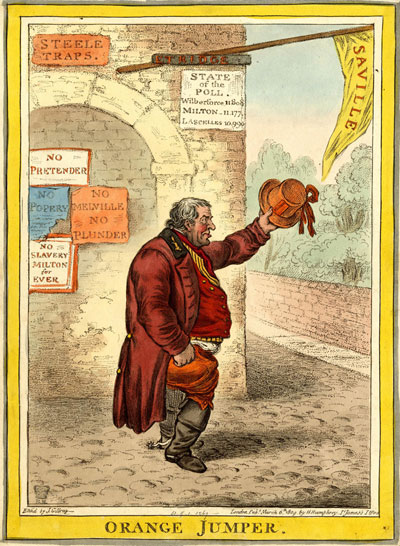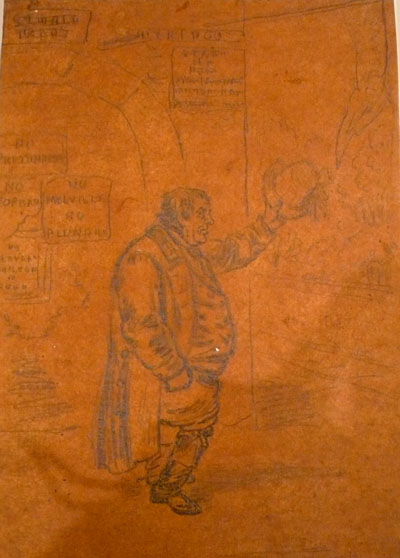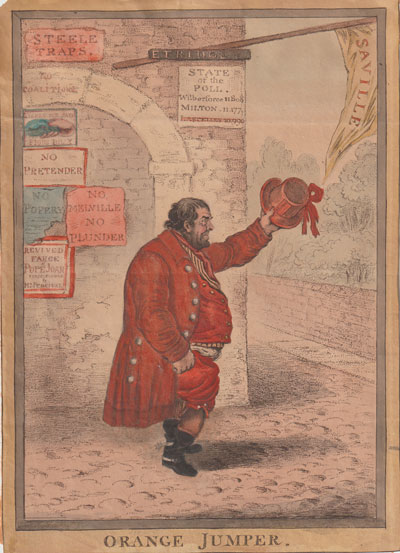Orange Jumper
According to Tim Clayton, whose book, James Gillray: A Revolution in Satire is a treasure trove of information about Gillray and his employers, the figure portrayed here is John Clarkson, also known as "Orange Jumper."

© Trustees of the British Museum
The image of a "fox" on his lapel, his orange hat with a ticket in its band inscribed "Milton," and the proximity of the extended hat to the pennant labeled "Saville" all identify Clarkson as a supporter of William Fitzwilliam, Viscount Milton, the Whig candidate in the hotly contested Yorkshire Election of 1807. Orange was Milton's color; and Sir George Saville was, as the British Museum commentary notes, the veritable "patron saint of the Yorkshire Whigs."
Clarkson is shown standing before the wall of Etridge's Inn, plastered over with placards and the final "State of the Poll" from the 1807 election. At that time, counties returned two candidates each, so as the poll numbers on the wall behind Orange Jumper accurately suggest, the election was closely contested among all three candidates: William Wilberforce running as an Independent, Viscount Milton as a Whig, and the Honourable Henry Lascelles as a Tory.
"Steele Traps" refers to a scandal involving Thomas Steele who had served as Paymaster General under William Pitt and who was accused of stealing money from the treasury for his personal use. "No Melville No Plunder" was another dig at Tory corruption. While Viscount Melville (aka Henry Dundas) was Treasurer, a naval enquiry revealed that his agent and paymaster Alexander Trotter had made "the bulk of his fortune by transferring public money from the Bank of England to his own credit at Coutts." Melville was implicated and nearly impeached. "No Pretender" and "No Popery" both refer to the always contentious issue of Catholic Emancipation which had once again been raised with the introduction of the Roman Catholic Army and Navy Service Bill in March of 1807. For the King and much of the British populace, however, any concessions to Catholics, even when their support could help the country in time of war, was a slippery slope to Popery and the return of a Stuart pretender. Finally, the sign "No Slavery Milton for Ever" reflects Milton's opposition to the slave trade and his difference from Lascelles whose father kept slaves on his West Indian plantation.
The print was commissioned by Francis Hawksworth of Hickleton Hall, an amateur artist, who had definitely commissioned at least one print from Gillray: [Tomb of Sir George Savile] (1799) and was likely responsible for another: A Little Snugger (1799). Both can be described as political portraits, celebrating the values of Yorkshire Whigs through two of their best known representatives, Sir George Saville and the Reverend Christopher Wyvill.
But why in March of 1809, almost 10 years later, would Francis Hawksworth commission another print from Gillray about an election which took place two years earlier in 1807? The answer, I think, comes back to Yorkshire politics and Hawksworth's family. Hawksworth was the younger brother of Walter Ramsden Hawksworth Fawkes, who assumed the name Fawkes when he inherited Farnley Hall in Otley in 1793. Fawkes was deeply involved in Yorkshire politics and had himself been elected as one of the two MPs for Yorkshire in November 1806 when the Pittite Lascelles declined to run. He was an anti-slavery proponent and moderate reformer and his support of Milton in 1807 had been instrumental in Milton's victory.
In the letter written to Gillray dated Thursday February 16, 1809 Hawksworth asks Gillray to work on the single figure Orange Jumper "some time next week.".* Later in the same letter, he reverts to the request again: "I hope you will oblige me by etching it next week—as Mr Fawkes wishes it and has many more things to execute for Him." The sense of urgency may stem from the fact that Fawkes was turning 40 on March 2. The election of 1807 had been a triumph for the Milton Whigs and for Fawkes's influence in the region (even in 1809, Milton was still one of the two Yorkshire MPs), so I'm guessing the print was intended as part of a birthday present for him.
But Gillray could not (or, in any case, did not) keep to Hawksworth's schedule. As late as March 17, 1809, Hawksworth is writing to Gillray :
Dear Sir,
This morning Mr. Fawkes received the etching of Orange Jumper – The upper part of the face – that is the forehead – eye & Hair are quite like Him, but the Nose and Mouth are both so much too large & so much caricatured that all the likeness of the man is entirely destroyed – I have burnt all you have sent, for They would quite disgrace me – & I request that you will not on any account dispose of a single copy of it in its present state – If you can alter the Lines of the nose & Mouth & make them exactly the same Lines as the drawing – I wish you wd do it but if the present one cannot be altered, I beg it may be immediately destroyed & send me down my original drawing...
In fact, Hawksworth had originally sent Gillray two drawings—one coloured and one uncoloured. He asked Gillray to use the coloured one as the basis for the face and upper body. "I never drew a stronger likeness than the face of the coloured drawing I enclose – The mouth is remarkable, a great deal of humour and rascality in it." But he requested that Gillray use the uncoloured drawing for the lower part of his body because "I made the legs & thigh too long" in the coloured version.
There is a tracing of what is probably the uncoloured drawing in the New York Public Library. The legs are short like the final print and seem appropriate for the squat figure of Orange Jumper. But the face differs from the print and lacks the "rascality" Hawksworth is so proud to have captured in the coloured version.

© New York Public Library
Photograph © by Ersy Contouris
So, given Hawksworth's insistence that Gillray etch the face "exactly" as it appears in Hawksworth's drawing, we can only guess that the face of Orange Jumper in the final print was based on an-as-yet-undiscovered tracing of Hawkworth's coloured drawing or was at least etched closely enough to the colored drawing to be acceptable to this very finicky amateur.
That leaves just one question: why does the finished print contain a publication date of March 6, 1809 when we know that Hawksworth was rejecting Gillray's first version on March 17th?
* All quotations from the Hawksworth correspondence are taken from an unpublished transcription by Tim Clayton of the Gillray Additional Manuscripts in the British Library. Thank you, Tim!
Addendum
Since finishing the write-up above, I received notice of an alternative print (not a drawing) of Orange Jumper in the possession of Donald Coverdale.

© Donald Coverdale, Private Collection
There are a number of differences between this and the two versions shown above, especially on the wall of Etridge's. On the placard showing the State of the Polls, the results for Lascelles are, in this version, crossed out. Above the alcove where most of the handbills are posted there is lettering spelling out "No Coalitions." Immediately beneath that writing is a sign with two hands grasping one another labeled "Tickle me says Pious Billy." And in place of the "No Slavery Milton for Ever"sign is another placard with the words "Revived Farce of Pope Joan First Riddle by Mr. Percival."
The "Tickle Me" reference is to The Gentle Denial. A New Ode dedicated to "the Worthy and Idependent Freeholders of thje County of York" and published in the Morning Chronicle for June 2, 1807. The Ode clearly suggests a coalition amounting to collusion between "pious Billy" (William Wilberforce) and "goood Lascelles."
If you (Lascelles) but tickle Billy,
He, in return, will tickle you.
The two hands of different colors are probably representations of Wilberforce and Lascelles "tickling pink and tickling blue." The Gentle Denial of the title is the pretense they both must maintain that they are not colluding: "Tho' joined, we must appear as Two!. . . 'You don't know me'—I don't know you'."
The reference to Pope Joan is most likely an allusion to Catholic Emancipation. The riddle may be that despite his overall support of Pitt (who resigned as Prime Minister over the issue), Perceval opposed Catholic Emancipation.
The figure of Orange Jumper in the variant print most resembles the tracing in the New York Public Library. The most obvious changes have to do with his coat and legs. The image of a fox on his lapel has been removed. The tail of the coat has been shortened. And the button holes have been replaced by buttons. The legs and feet are much smaller in proportion to the body in this variation differing in that respect from the New York Public Library tracing AND the final print.
But upon closer examination, according to Donald Coverdale, there is evidence of the signature and publication lines having been scratched away on the print itself. This suggests that it was created using the same copper plate as the one that Gillray "signed." But it also suggests that Gillray may not have been assoiciated with the production at all OR, at minimum, did not wish to have his name associated with it.
Sources and Reading
- Commentary from the British Museum on Orange Jumper.
- Tim Clayton, James Gillray: A Revolution in Satire "Orange Jumper," p.313.
- "William Wilberforce," Wikipedia
- "20 May 1807 Election," History of Parliament
- "Walter Fawkes," Wikipedia
- "William Fitzwilliam, 4th Earl Fitzwilliam, Viscount Milton," Wikipedia
- "Spencer Perceval" Wikipedia
- "LASCELLES, Hon. Henry (1767-1841), of Harewood House, Yorks.," History of Parliament
- Significant Scots: Henry Dundas
Comments & Corrections
NOTE: Comments and/or corrections are always appreciated. To make that easier, I have included a form below that you can use. I promise never to share any of the info provided without your express permission.